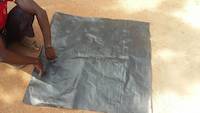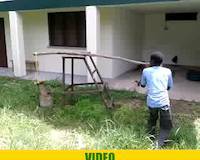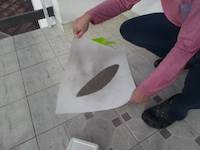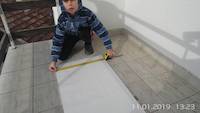Sampling methods and procedures
This guide provides instruction on the conventional practices of sample collection (standard sampling), coning/quartering, reducing samples for our team members, gold prospectors, and clients related tostarting a personal gold mine project.
The associated images or videos do not follow any specific sequence; they are recommended based on individual needs and queries regarding appropriate methods in handling and preparing samples.
- Proper sampling mixing and reduction on canvas
 We are training our staff members to understand and execute proper sampling procedures. On these pictures and video you may observe how we have taken every third scoop from each bucket with gold concentrates, thereafter we have been using standard mixing methods and reduction of sample by quartering until we remained with just a kilogram or less. The final sample can be taken to the laboratory for assaying.
We are training our staff members to understand and execute proper sampling procedures. On these pictures and video you may observe how we have taken every third scoop from each bucket with gold concentrates, thereafter we have been using standard mixing methods and reduction of sample by quartering until we remained with just a kilogram or less. The final sample can be taken to the laboratory for assaying. - Leverage with mortar and pestle to crush larger rocks
 This is one way on how to easier crush larger rocks during sampling process. The leverage may be used to raise the mortar and crush the rocks in the pestle. Even child of 12 years can handle the leverage and help in such operation. We don't employ children. This is was our neighbor in Mwanza who helped to make this movie.
This is one way on how to easier crush larger rocks during sampling process. The leverage may be used to raise the mortar and crush the rocks in the pestle. Even child of 12 years can handle the leverage and help in such operation. We don't employ children. This is was our neighbor in Mwanza who helped to make this movie. - Mixing the smple on table oilcloth, nylon or plastic canvas
 This series of pictures will demonstrate how to mix the sample on the table oilcloth, nylon or plastic canvas. The procedure is standard, hundred yeasr old yet not as known and practiced by small scale miners in Africa.
This series of pictures will demonstrate how to mix the sample on the table oilcloth, nylon or plastic canvas. The procedure is standard, hundred yeasr old yet not as known and practiced by small scale miners in Africa. - How to prepare the square table oilcloth for sample mixing
 These pictures will show how to prepare the square table oilcloth or other type of plastic canvas for purposes of mixing the sample. The process is simple, find out what is the quantity of the sample, try to estimate the square size, find the table oilcloth, measure its width and if width is good enough for the sample size, cut it to the length of the width, and you have got the square. While this process may be sample in its words to some people, to some other people it is complicated. Pictures are there to give the mass to the reader so that process can be easier understood.
These pictures will show how to prepare the square table oilcloth or other type of plastic canvas for purposes of mixing the sample. The process is simple, find out what is the quantity of the sample, try to estimate the square size, find the table oilcloth, measure its width and if width is good enough for the sample size, cut it to the length of the width, and you have got the square. While this process may be sample in its words to some people, to some other people it is complicated. Pictures are there to give the mass to the reader so that process can be easier understood.
Coning and Quartering
Coning and quartering is a method used for sampling solid materials, particularly minerals or rocks during the early stages of mineral processing. The technique involves breaking down larger samples into smaller fractions to ensure that all parts are represented equally.
Here’s how it works:
- Cone Formation: A sample pile (often cylindrical) is formed on top of an inverted cone.
- Quartering Process:
- The conical stack is divided vertically through its center, creating two equal halves.
- Each half is then split horizontally into quarters by making a cut parallel to the base at approximately one-third and two-thirds height from the bottom.
The four resulting sections are typically separated out with only alternate ones (quarters) being retained for further testing. This process ensures that each section has an even distribution of material, reducing bias in analysis due to sampling errors.
Coning and quartering is crucial as it provides a representative sample without requiring extensive mixing or other preparation methods.
This method helps ensure the accuracy of subsequent tests on mineral composition, hardness, grain size distributions etc., which are essential for understanding ore characteristics before processing.